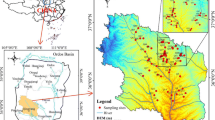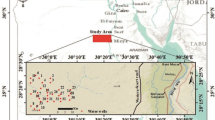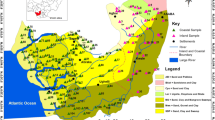Abstract
The evolution of hydrochemical compositions influenced by long-period interactions between groundwater and the geo-environment is a fundamental issue for exploring groundwater quality and vulnerability. This study systematically investigated the hydrochemical processes and anthropogenic interference occurring in the river basin by bivariate plots, Gibbs diagrams, saturation index, and the major ions ratios. Apparent changes in groundwater hydrochemistry have been observed in the study area, illustrating the origins of major ions are affected by various internal and external factors. Results highlighted that TDS varied from freshwater to brackish water, ranging between 187.90 and 2294.81 mg/L. Ca2+ and HCO −3 are the dominant ions in the studied samples. The results gained by Gibbs diagrams, bivariate plots, saturation index, and the major ions ratios demonstrated that minerals dissolution/precipitation, cation exchange, and human inputs play crucial roles in the unconfined aquifers. Moreover, the overuse of nitrogen fertilizer, livestock manure, and industrial/domestic sewage led to nitrate and nitrite contamination and brought significant challenges to the surrounding hydrogeo-environment. The present study could make an unambiguous identification of natural processes and anthropogenic interventions influencing groundwater hydrochemistry’s long-period evolution and create a preliminary strategy for groundwater resources management.

Similar content being viewed by others
References
Alley W M, Healy R W, LaBaugh J W, Reilly T E (2002). Flow and storage in groundwater systems. Science, 296(5575): 1985–1990
Argamasilla M, Barberá J A, Andreo B (2017). Factors controlling groundwater salinization and hydrogeochemical processes in coastal aquifers from southern Spain. Science of the Total Environment, 580: 50–68
Ascott M J, Gooddy D C, Wang L, Stuart M E, Lewis M A, Ward R S, Binley A M (2017). Global patterns of nitrate storage in the vadose zone. Nature Communications, 8: 1416
Busico G, Kazakis N, Cuoco E, Colombani N, Tedesco D, Voudouris K, Mastrocicco M (2020). A novel hybrid method of specific vulnerability to anthropogenic pollution using multivariate statistical and regression analyses. Water Research, 171: 115386
Cao F, Jaunat J, Vergnaud-Ayraud V, Devau N, Labasque T, Guillou A, Guillaneuf A, Hubert J, Aquilina L, Ollivier P (2020). Heterogeneous behaviour of unconfined Chalk aquifers infer from combination of groundwater residence time, hydrochemistry and hydrodynamic tools. Journal of Hydrology (Amsterdam), 581: 124433
Chen F, Jia G, Chen J (2009). Nitrate sources and watershed denitrification inferred from nitrate dual isotopes in the Beijiang River, south China. Biogeochemistry, 94(2): 163–174
Chen J, Qian H, Gao Y, Wang H, Zhang M (2020). Insights into hydrological and hydrochemical processes in response to water replenishment for lakes in arid regions. Journal of Hydrology (Amsterdam), 581: 124386
Erostate M, Huneau F, Garel E, Vystavna Y, Santoni S, Pasqualini V (2019). Coupling isotope hydrology, geochemical tracers and emerging compounds to evaluate mixing processes and groundwater dependence of a highly anthropized coastal hydrosystem. Journal of Hydrology (Amsterdam), 578: 123979
Fu C, Li X, Ma J, Liu L, Gao M, Bai Z (2018). A hydrochemistry and multi-isotopic study of groundwater origin and hydrochemical evolution in the middle reaches of the Kuye River basin. Applied Geochemistry, 98: 82–93
Gibbs R J (1970). Mechanisms controlling world water chemistry. Science, 170(3962): 1088–1090
Gopinath S, Srinivasamoorthy K, Saravanan K, Prakash R (2019). Tracing groundwater salinization using geochemical and isotopic signature in Southeastern coastal Tamilnadu, India. Chemosphere, 236: 124305
Han D M, Song X F, Currell M J, Yang J L, Xiao G Q (2014). Chemical and isotopic constraints on evolution of groundwater salinization in the coastal plain aquifer of Laizhou Bay, China. Journal of Hydrology (Amsterdam), 508: 12–27
Huang G, Liu C, Sun J, Zhang M, Jing J, Li L (2018). A regional scale investigation on factors controlling the groundwater chemistry of various aquifers in a rapidly urbanized area: A case study of the Pearl River Delta. Science of the Total Environment, 625: 510–518
Isa N M, Aris A Z, Sulaiman W N A W (2012). Extent and severity of groundwater contamination based on hydrochemistry mechanism of sandy tropical coastal aquifer. Science of the Total Environment, 438: 414–425
Jampani M, Liedl R, Hiilsmann S, Sonkamble S, Amerasinghe P (2020). Hydrogeochemical and mixing processes controlling groundwater chemistry in a wastewater irrigated agricultural system of India. Chemosphere, 239: 124741
Jia H, Qian H, Zheng L, Feng W, Wang H, Gao Y (2020). Alterations to groundwater chemistry due to modern water transfer for irrigation over decades. Science of the Total Environment, 717: 137170
Kim J H, Kim K H, Thao N T, Batsaikhan B, Yun S T (2017). Hydrochemical assessment of freshening saline groundwater using multiple end-members mixing modeling: A study of Red River delta aquifer, Vietnam. Journal of Hydrology (Amsterdam), 549: 703–714
Koba K, Tokuchi N, Wada E, Nakajima T, Iwatsubo G (1997). Intermittent denitrification: The application of a 15N natural abundance method to a forested ecosystem. Geochimica et Cosmochimica Acta, 61(23): 5043–5050
Lee K S, Bong Y S, Lee D, Kim Y, Kim K (2008). Tracing the sources of nitrate in the Han River watershed in Korea, using δ15N-NO −3 and δ18O-NO −3 values. Science of the Total Environment, 395(2–3): 117–124
Li J, Pang Z, Froehlich K, Huang T, Kong Y, Song W, Yun H (2015). Paleo-environment from isotopes and hydrochemistry of groundwater in East Junggar Basin, Northwest China. Journal of Hydrology (Amsterdam), 529: 650–661
Li X, Tang C, Cao Y, Li D (2020). A multiple isotope (H, O, N, C and S) approach to elucidate the hydrochemical evolution of shallow groundwater in a rapidly urbanized area of the Pearl River Delta, China. Science of the Total Environment, 724: 137930
Liu C Q, Li S L, Lang Y C, Xiao H Y (2006). Using δ15N- and δ18O-values to identify nitrate sources in karst ground water, Guiyang, Southwest China. Environmental Science & Technology, 40(22): 6928–6933
Liu G Q, Zhou S Y, Huang X D, Wang T, Xu D, Yue C D (2017). Multiple methods to recognize sources of underground water nitrate contamination in plain area of Dagu River, Qingdao, China. Acta Science Circumstance, 37: 347–356 (in Chinese)
Lv P C, Xing T J, Zhao F (2017). Comprehensive Technical Report of Geological Environment Monitoring and Evaluation in Qingdao City of Shandong Province, China. Qingdao: Qingdao Geo-Engineering Exploration Institute, China (in Chinese)
Malov A I, Tokarev I V (2019). Using stable isotopes to characterize the conditions of groundwater formation on the eastern slope of the Baltic Shield (NW Russia). Journal of Hydrology (Amsterdam), 578: 124130
Molinari A, Guadagnini L, Marcaccio M, Guadagnini A (2019). Geostatistical multimodel approach for the assessment of the spatial distribution of natural background concentrations in large-scale groundwater bodies. Water Research, 149: 522–532
Mondal N C, Singh V P, Singh V S, Saxena V K (2010). Determining the interaction between groundwater and saline water through groundwater major ions chemistry. Journal of Hydrology (Amsterdam), 388(1–2): 100–111
Naseem S, Rafique T, Bashir E, Bhanger M I, Laghari A, Usmani T H (2010). Lithological influences on occurrence of high-fluoride groundwater in Nagar Parkar area, Thar Desert, Pakistan. Chemosphere, 78(11): 1313–1321
Negrel P, Roy S, Petelet-Giraud E, Millot R, Brenot A (2007). Longterm fluxes of dissolved and suspended matter in the Ebro River Basin (Spain). Journal of Hydrology (Amsterdam), 342(3–4): 249–260
Nguyen T T, Kawamura A, Tong T N, Amaguchi H, Nakagawa N, Gilbuena R Jr, Bui D D (2015). Identification of spatio-seasonal hydrogeochemical characteristics of the unconfined groundwater in the Red River Delta, Vietnam. Applied Geochemistry, 63: 10–21
Ovalle ARC, Silva C F, Rezende C E, Gatts C E N, Suzuki M S, Figueiredo R O (2013). Long-term trends in hydrochemistry in the Paraíba do Sul River, southeastern Brazil. Journal of Hydrology (Amsterdam), 481: 191–203
Pacetti T, Lompi M, Petri C, Caporali E (2020). Mining activity impacts on soil erodibility and reservoirs silting: Evaluation of mining decommissioning strategies. Journal of Hydrology (Amsterdam), 589: 125107
Pant R R, Zhang F, Rehman F U, Wang G, Ye M, Zeng C, Tang H (2018). Spatiotemporal variations of hydrogeochemistry and its controlling factors in the Gandaki River Basin, Central Himalaya Nepal. Science of the Total Environment, 622–623: 770–782
Reiller P E, Descostes M (2020). Development and application of the thermodynamic database PRODATA dedicated to the monitoring of mining activities from exploration to remediation. Chemosphere, 251: 126301
Singh KP, Gupta S, Mohan D (2014). Evaluating influences of seasonal variations and anthropogenic activities on alluvial groundwater hydrochemistry using ensemble learning approaches. Journal of Hydrology (Amsterdam), 511: 254–266
Song J, Yang Y, Wu J, Wu J, Sun X, Lin J (2018). Adaptive surrogate model based multiobjective optimization for coastal aquifer management. Journal of Hydrology (Amsterdam), 561: 98–111
Song X, Sun W, Zhang Y, Song S, Li J, Gao Y (2020). Using hydrological modelling and data-driven approaches to quantify mining activities impacts on centennial streamflow. Journal of Hydrology (Amsterdam), 585: 124764
Swartjes F A, Otte P F (2017). A novel concept in ground water quality management: Towards function specific screening values. Water Research, 119: 187–200
Wang H, Jiang X W, Wan L, Han G, Guo H (2015). Hydrogeochemical characterization of groundwater flow systems in the discharge area of a river basin. Journal of Hydrology (Amsterdam), 527: 433–441
Wang Y, Shvartsev S L, Su C (2009). Genesis of arsenic/fluoride-enriched soda water: A case study at Datong, northern China. Applied Geochemistry, 24(4): 641–649
Widory D, Petelet-Giraud E, Négrel P, Ladouche B (2005). Tracking the sources of nitrate in groundwater using coupled nitrogen and boron isotopes: A synthesis. Environmental Science & Technology, 39(2): 539–548
Wu H, Wu J, Li J, Fu C (2020). Spatial variations of hydrochemistry and stable isotopes in mountainous river water from the Central Asian headwaters of the Tajikistan Pamirs. Catena, 193: 104639
Xiong G, An Q, Fu T, Chen G, Xu X (2020). Evolution analysis and environmental management of intruded aquifers of the Dagu River Basin of China. Science of the Total Environment, 719: 137260
Yin Z Y, Lin Q, Xu S H (2018). Spatio-temporal variations and controlling factors of groundwater hydrochemical characteristics in the Dagu River Basin. Dizhi Lunping, 64: 1030–1043 (in Chinese)
Yue F J, Li S L, Liu C Q, Zhao Z Q, Hu J (2013). Using dual isotopes to evaluate sources and transformation of nitrogen in the Liao River, northeast China. Applied Geochemistry, 36: 1–9
Zeng X, Dong J, Wang D, Wu J, Zhu X, Xu S, Zheng X, Xin J (2018). Identifying key factors of the seawater intrusion model of Dagu river basin, Jiaozhou Bay. Environmental Research, 165: 425–430
Zhang B, Zheng X, Zheng T, Xin J, Sui S, Zhang D (2019). The influence of slope collapse on water exchange between a pit lake and a heterogeneous aquifer. Frontiers of Environmental Science & Engineering, 13(2): 20
Zhu B, Yang X, Rioual P, Qin X, Liu Z, Xiong H, Yu J (2011). Hydrogeochemistry of three watersheds (the Erlqis, Zhungarer and Yili) in northern Xinjiang, NW China. Applied Geochemistry, 26(8): 1535–1548
Acknowledgements
This research is supported by the National Natural Science Foundation of Chinaunder Grant Nos. 41571214 and 41807010. The authors are also grateful to Prof. Zhaomao Liu of Qingdao Geo-Engineering Exploration Institute, China for his thoughtful and constructive comments.
Author information
Authors and Affiliations
Corresponding author
Additional information
Highlights
• The long-period groundwater evolution was identified by hydrochemical signatures.
• The dominant processes in the groundwater evolution were verified.
• Groundwater quality in the coastal areas was susceptible to deterioration due to SI.
• Groundwater contamination arose from fertilizer, livestock manure & domestic sewage.
Rights and permissions
About this article
Cite this article
Yin, Z., Lin, Q. & Xu, S. Using hydrochemical signatures to characterize the long-period evolution of groundwater information in the Dagu River Basin, China. Front. Environ. Sci. Eng. 15, 105 (2021). https://doi.org/10.1007/s11783-021-1393-7
Received:
Revised:
Accepted:
Published:
DOI: https://doi.org/10.1007/s11783-021-1393-7




